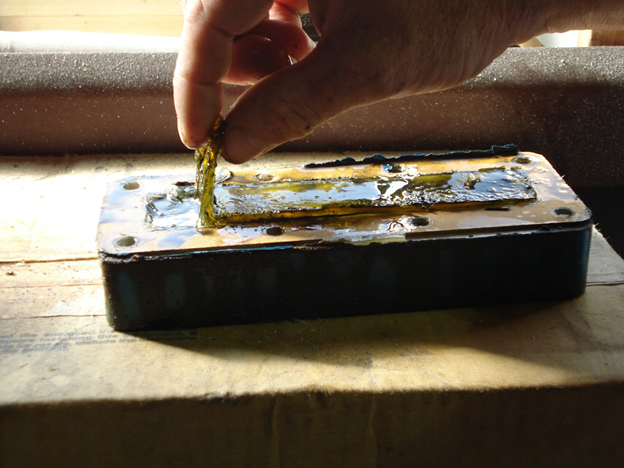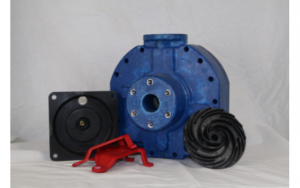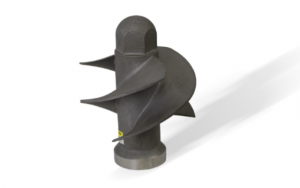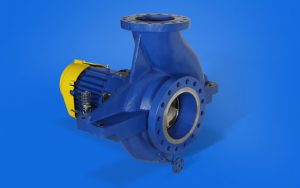Contributor: Carver Pump
Amine is an aqueous solution that is pumped during a portion of the gas scrubbing process at refineries, petrochemical plants and natural gas processing plants. The various alkylamines in the amine are combined with the ‘sour’ gas to remove hydrogen sulfide, carbon dioxide, and other nasty impurities. This is often referred to as “sweetening the gas”. In this process, amine is typically pumped up to spray nozzles in the scrubbing towers where the amine is atomized into a fine spray. The atomized amine bonds to these impurities in a chemical reaction that then easily separates them from the natural gas.
Amine scrubbing chemicals reach the towers through high pressure ring section pumps. High pressures are often required to force the amine through nozzles into the pressurized gas column. Ring section pumps, operating at pressures up to 1,400 PSI, are often installed in pairs, as one is typically utilized as a “standby” or back-up pump.
Amine is not a highly corrosive fluid, so when selecting your pump for an amine scrubbing application standard cast iron or ductile iron are usually acceptable for this kind of application. However, when choosing a mechanical seal and o-rings, it’s very important to choose the correct elastomers as the seal materials need to stand up to the amine.
It is also important to know that not every pump manufacturer tries to isolate the fluid from the lubrication of the bearings – but it is a “best practice” to isolate the fluid. Just like in your car, you don’t want to mix the cooling water with the oil and you don’t want the oil coming out of your engine onto the ground. Amine, which is a very slippery substance, can be very sneaky. It can leak from the seal and make a path into the lubrication oil of the bearings. If amine gets in there, it will break down the oil and cause it to lose its viscosity. The oil will darken and convert into a plastic-like material (as pictured below).
 Now that you know amine can crawl along the shaft and find a leak path into the bearing oil, you can make decisions to help prevent that from occurring. To keep amine from creeping into the bearing chamber, a “flinger” can be utilized on the shaft between the mechanical seal and the oil seal. Imagine a little fan blade on the front of your bearings – this is a flinger. If flingers are positioned ahead of the seal on the bearings, it will fling away the amine that is creeping along the shaft.
Now that you know amine can crawl along the shaft and find a leak path into the bearing oil, you can make decisions to help prevent that from occurring. To keep amine from creeping into the bearing chamber, a “flinger” can be utilized on the shaft between the mechanical seal and the oil seal. Imagine a little fan blade on the front of your bearings – this is a flinger. If flingers are positioned ahead of the seal on the bearings, it will fling away the amine that is creeping along the shaft.
We strongly recommend using labyrinth seals instead of lip seals. Labyrinth seals, like the ones made by Inpro/Seal, work much better at keeping the fluid in the bearing area and preventing contaminants from getting into the pump. Amine in the oil will cause rapid bearing failure, but if the correct pump and components are selected, operation can continue up to 50,000 hours (or 5 years on a 24/7 basis).
Before selecting a ring section pump, have a discussion with the manufacturer’s engineers about the operating conditions, NPSHr, temperature of liquid, physical space and piping configuration, seal flush options, and other conditions of service for the accurate selection of your pumps.
About Carver Pump
Since we built our first pumps in 1938, Carver Pump has become recognized as one of the leading centrifugal pump companies, building pumps to the most demanding engineering specifications and military standards in the world. We were one of the first American pump companies to attain ISO 9001 certification – the most recognized standard for quality in the world. This certification is your assurance that our commitment to quality includes not only our hardware, but also superior customer service, leading-edge R&D, and continuous improvement in everything we do. So whether the job is refueling fighter jets on the deck of an aircraft carrier, supplying paint to an auto assembly line, or bringing water to the fountain in a city park, we put our reputation on the line everyday with every pump we build. Learn more at www.carverpump.com.





Comments